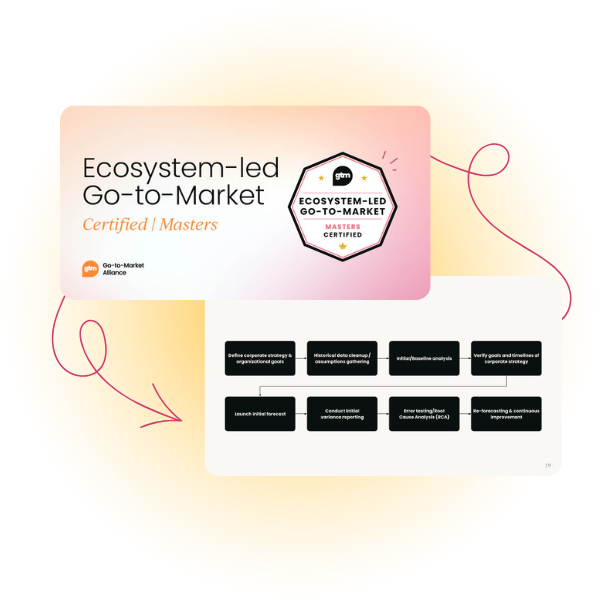PMMs are rightly criticized for forgetting this
Product managers and product marketers are often criticized.
The rub? They focus too much on the product itself and not enough on the customer.
You see the term “customer-centricity” on product webpages, mission statements, and marketing material. But what does it actually mean to create a truly customer-centric product? How do you ensure that your solution addresses the real needs of your users and buyers?
One of the best ways to achieve this is through design thinking.
What design thinking is
Originally created by Tim Brown from IDEO, design thinking is often thought of as a tool only for designers or developers. This is wrong. Design thinking is highly relevant for product marketers and anyone involved in a go-to-market strategy. How so? It helps you understand the customer deeply, and develop solutions that resonate with them.
How design thinking improves GTM strategy
You might have all the right marketing frameworks, but design thinking adds creativity that makes your strategy more customer-focused. It helps you test and improve ideas quickly. By focusing on the customer’s real needs, gathered through real-time tests, your go-to-market plan becomes more meaningful and useful. Design thinking also encourages teamwork and faster innovation across marketing teams.
How to apply design thinking to GTM strategies in 5 steps
Here's a 5-step method to apply design thinking when creating your go-to-market strategy:
- Empathize with your users and buyers
- Define the problem clearly
- Ideate and collaborate across functions
- Test and validate in the real world
- Iterate continuously
1 - Empathize with your users and buyers
The first phase of design thinking is empathizing. Many teams create personas and stop there. However, truly understanding the user goes far beyond personas. It is about stepping into their shoes and understanding their motivations, aspirations, frustrations, and the jobs they need to get done.
The best way to do this is through research. This research should cover both users and buyers. In many cases, the product may serve one group of users but be purchased by another.
For example, consider a patient scheduling software. It helps both patients and front-end staff, but the buyer could be the finance leader of a physician group. Understanding both perspectives is critical for creating a successful go-to-market strategy.
Direct conversations with users are one of the most effective research methods. Conduct interviews to uncover the reasons behind their behaviors. This can reveal insights about their priorities, pain points, and what drives their decisions.
Customer journey mapping is another useful tool. This involves mapping the entire experience of the user or buyer, from when they encounter a problem to the solutions they try. It highlights pain points, missed opportunities, and their jobs to be done.

A Tesla user shared a tweet suggesting a simple feature: display a message on the car screen saying the air conditioning is on, so people wouldn’t break the windows—and keep his pet cool at the same time. Elon Musk saw it and actually made it happen in Teslas with the ‘Dog Mode’ feature! This is a perfect example of listening to customers, showing empathy, and turning an idea into innovative action.

If you work in B2B software, do not forget to interview your sales team members. They speak with the customer every day and have fresh insights about both the customer and the competition.
While doing this research, it is essential to remove biases and avoid jumping to conclusions. The goal is to gain a deep understanding of the customer without assuming you already know the answers.
2 - Define the problem clearly
After gathering insights, the next step is defining the problem. Many teams fall into the trap of thinking about the solution too early. Instead, the focus should be on clearly stating the problem.
For example, if you are selling patient scheduling software to a hospital, the problem should not be defined as ‘reducing patient dissatisfaction by 20 percent’.
A better way to define it is to ask how you might make the ‘patient experience regarding scheduling more positive, seamless, and timely so that patients feel well cared for’. This approach opens up a wider range of possible solutions and allows your team to explore ideas creatively.
A well-defined problem statement ensures that the solutions generated are aligned with real customer needs rather than assumptions.
3 - Ideate and collaborate across functions
The ideation phase is where creativity comes into play. This is the time to generate as many ideas as possible without filtering them too early. For a product launch, consider creating a tiger team made up of cross-functional stakeholders. Include members from product management, sales, and customer success.
During ideation, you also start prototyping. In the context of go-to-market strategy, prototypes are not physical products but frameworks, messaging documents, and positioning statements. For example, you could create a positioning framework for your product launch and iterate on it based on research and data. Similarly, a messaging document will serve as a foundation for sales collateral, website copy, and marketing campaigns.
Collaborative prototyping ensures that all stakeholders are aligned and can contribute to the development of a strong, customer-focused launch strategy. Iteration is key here. Use feedback to refine your prototypes and improve the overall approach.
4 - Test and validate in the real world
Once you have prototypes, it is time to test them. Testing allows you to validate assumptions and see if your messaging and positioning resonate with the target audience. For example, you can message test your value props and marketing copy and show it to a sample of prospects. Pay attention to whether they find it differentiated, relevant, and compelling.
One example of iterating based on user feedback is Slack’s rebranding campaign. The new logo was meant to look modern and versatile, but many people found it confusing and hard to recognize. Slack responded quickly, listened to the feedback, and made small adjustments to improve the logo. They didn’t redo everything, just fixed the parts that caused negative reactions. This shows how a B2B brand can use user feedback to guide marketing and branding decisions.

You can also run minimum viable marketing campaigns. For instance, create a small digital campaign on LinkedIn targeted to your ideal audience. Measure the response and engagement to learn what works and what needs adjustment. These real-world tests provide critical insights before launching full-scale campaigns, reducing the risk of missed opportunities or misaligned messaging.
5 - Iterate continuously
Design thinking is not a one-time process. It requires continuous iteration. As you gather feedback from users, buyers, and the market, you can refine your messaging, positioning, and go-to-market strategies. This continuous loop of learning, ideation, prototyping, and testing ensures that your product remains aligned with customer needs and market realities.
Forge industry alliances and become unbeatable
Looking for the full, actionable low-down on building partnership strategies?
Sign up to Ecosystem Go-to-Market: Masters and Reach new audiences, amplify your messaging, and finally sell at scale when you learn how to leverage strategic partnerships the right way.




 Follow us on LinkedIn
Follow us on LinkedIn



